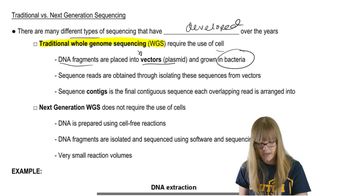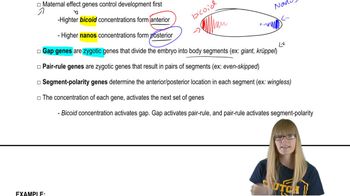Table of contents
- 1. Introduction to Genetics51m
- 2. Mendel's Laws of Inheritance3h 37m
- 3. Extensions to Mendelian Inheritance2h 41m
- 4. Genetic Mapping and Linkage2h 28m
- 5. Genetics of Bacteria and Viruses1h 21m
- 6. Chromosomal Variation1h 48m
- 7. DNA and Chromosome Structure56m
- 8. DNA Replication1h 10m
- 9. Mitosis and Meiosis1h 34m
- 10. Transcription1h 0m
- 11. Translation58m
- 12. Gene Regulation in Prokaryotes1h 19m
- 13. Gene Regulation in Eukaryotes44m
- 14. Genetic Control of Development44m
- 15. Genomes and Genomics1h 50m
- 16. Transposable Elements47m
- 17. Mutation, Repair, and Recombination1h 6m
- 18. Molecular Genetic Tools19m
- 19. Cancer Genetics29m
- 20. Quantitative Genetics1h 26m
- 21. Population Genetics50m
- 22. Evolutionary Genetics29m
15. Genomes and Genomics
Sequencing the Genome
Problem 3d
Textbook Question
When the whole-genome shotgun sequence of the Drosophila genome was assembled, it comprised 134 scaffolds made up of 1636 contigs.
How can sequence gaps be closed?
 Verified step by step guidance
Verified step by step guidance1
<span>Step 1: Understand the concept of sequence gaps. Sequence gaps occur when there are missing sequences between contigs in a scaffold. These gaps need to be filled to create a continuous sequence.</span>
<span>Step 2: Use paired-end reads. Paired-end reads are sequences obtained from both ends of a DNA fragment. They can help bridge gaps by aligning the ends of contigs that are separated by a gap.</span>
<span>Step 3: Employ mate-pair libraries. Mate-pair libraries involve longer DNA fragments, which can span larger gaps between contigs, providing additional information to close gaps.</span>
<span>Step 4: Utilize PCR amplification. Design primers that flank the gap regions to amplify and sequence the missing DNA, thereby closing the gaps.</span>
<span>Step 5: Apply computational methods. Use bioinformatics tools and algorithms to predict and fill gaps based on sequence similarity and other genomic data.</span>
Recommended similar problem, with video answer:
 Verified Solution
Verified SolutionThis video solution was recommended by our tutors as helpful for the problem above
Video duration:
1mPlay a video:
Was this helpful?
Key Concepts
Here are the essential concepts you must grasp in order to answer the question correctly.
Whole-Genome Shotgun Sequencing
Whole-genome shotgun sequencing is a method used to sequence an entire genome by randomly breaking the DNA into small fragments, sequencing those fragments, and then assembling them based on overlapping regions. This approach allows for rapid sequencing of large genomes, such as that of Drosophila, but often results in gaps that need to be addressed for a complete assembly.
Recommended video:
Guided course

Sequencing Overview
Contigs and Scaffolds
Contigs are contiguous sequences of DNA that are assembled from overlapping fragments, while scaffolds are larger structures that consist of multiple contigs linked together. In genome assembly, scaffolds help provide a framework for the genome, but gaps may exist between contigs, necessitating further work to close these gaps and achieve a more complete representation of the genome.
Recommended video:
Guided course

Traditional vs. Next-Gen
Gap Closure Techniques
Gap closure techniques involve various strategies to fill in the sequence gaps identified in genome assemblies. These can include using paired-end reads to bridge gaps, employing PCR amplification to obtain missing sequences, or utilizing long-read sequencing technologies that can span larger regions of DNA, thereby providing more complete and accurate genome assemblies.
Recommended video:
Guided course

Segmentation Genes

 8:55m
8:55mWatch next
Master Sequencing Overview with a bite sized video explanation from Kylia Goodner
Start learning


